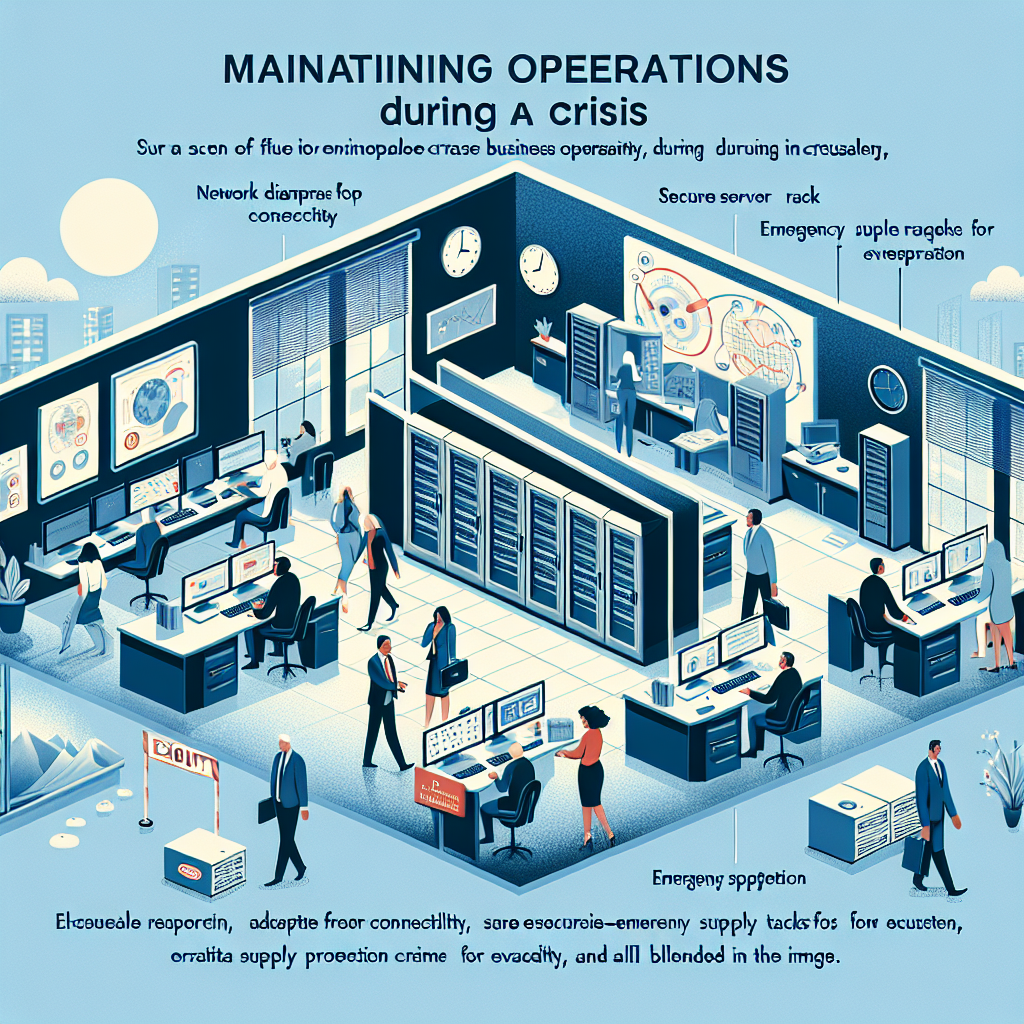Your cart is currently empty!
Tag: Crisis

Business Continuity Best Practices: Tips for Maintaining Operations in a Crisis
In today’s unpredictable world, businesses face a myriad of threats that can disrupt their operations at any moment. From natural disasters to cyber-attacks to pandemics, it’s essential for organizations to have a solid business continuity plan in place to ensure they can maintain operations in the face of a crisis.Here are some best practices for maintaining business continuity in a crisis:
1. Develop a comprehensive business continuity plan: The first step in ensuring your business can weather any storm is to create a detailed business continuity plan. This plan should outline the steps your organization will take to ensure critical operations can continue in the event of a crisis. It should include protocols for communication, backup systems, and alternative work arrangements.
2. Conduct a risk assessment: Understanding the potential threats your business faces is crucial to developing an effective business continuity plan. Conduct a thorough risk assessment to identify the most likely scenarios that could disrupt your operations, and develop strategies to mitigate those risks.
3. Establish a crisis management team: In the event of a crisis, it’s essential to have a dedicated team in place to manage the situation. This team should be responsible for coordinating the response, communicating with stakeholders, and implementing the business continuity plan.
4. Regularly test and update your plan: A business continuity plan is only effective if it’s regularly tested and updated. Conduct regular drills and exercises to ensure your team is prepared to respond to a crisis, and make updates to the plan as needed based on lessons learned.
5. Maintain open lines of communication: Communication is key in a crisis situation. Ensure that you have multiple channels for communicating with employees, customers, suppliers, and other stakeholders, and keep them informed of any developments as they occur.
6. Implement remote work capabilities: In today’s digital age, many businesses can continue operations remotely in the event of a crisis. Implementing remote work capabilities for your employees can help ensure that critical functions can continue even if your physical office is inaccessible.
7. Establish relationships with key partners and suppliers: In a crisis, it’s essential to have strong relationships with key partners and suppliers. Establishing these relationships ahead of time can help ensure that you have the support you need to maintain operations when disaster strikes.
By following these best practices, businesses can increase their resilience and ensure they can maintain operations in the face of any crisis. A solid business continuity plan, regular testing and updates, effective communication, and strong relationships with partners and suppliers are all key components of a successful business continuity strategy.
Sudden Fed ‘Financial Crisis’ Fear Sparks Huge Bitcoin And Crypto Price Crash Prediction
Bitcoin and crypto prices have moved sharply lower, diving along with a stock market sell-off sparked by the surging popularity of China-based artificial intelligence app DeepSeek.
Unlock over $3,000 in NFT, web3 and crypto perks — Apply now!
The bitcoin price has dropped under $100,000 per bitcoin, down from an all-time high of almost $110,000 ahead of U.S. president Donald Trump’s inauguration (despite the chief executive of major bitcoin and crypto exchange Coinbase predicting when the bitcoin price could flip gold’s $18 trillion).
Now, as BlackRock’s Larry Fink reveals his discussions with sovereign wealth funds about buying bitcoin, closely-watched crypto trader Arthur Hayes has warned of a looming “financial crisis” that he expects to unleash fresh Federal Reserve stimulus measures.
Sign up now for the free CryptoCodex—A daily five-minute newsletter for traders, investors and the crypto-curious that will get you up to date and keep you ahead of the bitcoin and crypto market bull run
Federal Reserve chair Jerome Powell has been warned of a looming “financial crisis” that could crash … [+]
“I am calling for a $70,000 to $75,000 correction in bitcoin [and] a mini financial crisis,” Hayes, a cofounder of bitcoin and crypto derivatives pioneer BitMex who went on to set up the Maelstrom investment fund, posted to X.
Bitcoin rocketed past $70,000 on the back of Donald Trump’s November election victory as traders bet Trump will spur the growth of bitcoin and crypto.
Last week, Trump followed through on his campaign promises to make overhauling crypto policy one of his administration’s priorities, ordering the creation of a bitcoin and cryptocurrency working group tasked with proposing new regulations and exploring the creation of a national cryptocurrency stockpile.
The bitcoin price is closely correlated to the U.S. stock market, with bitcoin and crypto trading in line with high-growth tech stocks that have surged due to the rush into artificial intelligence since 2022 but now look at risk as DeepSeek achieves performance similar OpenAI’s models with fewer chip requirements.
“Risk-off is the theme as DeepSeek scares investors,” market analyst Adam Kobeissi posted to X, pointing to the crypto and bitcoin price sell-off that’s seen ethereum rival solana drop 10%.
Sign up now for CryptoCodex—A free, daily newsletter for the crypto-curious
The bitcoin price has surged to an all-time high this year, though fears have emerged a bitcoin … [+]
“Nasdaq 100 futures are now down -330 points since the market opened just hours ago as DeepSeek takes #1 on the App Store. This is how you know DeepSeek has become a major threat to U.S. large cap tech,” Kobeissi’s market advisory service account posted.
This week, the Federal Reserve is widely expected to leave interest rates on hold when it meets for its first policy meeting since Trump assumed office on Wednesday, though Trump has said he wants the Fed to bring interest rates down.
“With oil prices going down, I’ll demand that interest rates drop immediately, and likewise they should be dropping all over the world,” Trump told World Economic Forum attendees last week.
However, Hayes said he believes the Fed will resume “money printing that will send [the bitcoin price] to $250,000 by the end of the year.”
U.S. debt has soared over recent years, topping $34 trillion at the beginning of 2024, with Covid and lockdown stimulus measures contributing to massive government spending and helping to send inflation spiraling out of control in 2022.
Inflation of over 10% forced the Federal Reserve to hike interest rates at a historical clip, pushing up debt interest payments and fueling fears of a “death spiral.”
The recent fear of a sudden financial crisis from the Federal Reserve has sparked a huge prediction of a Bitcoin and cryptocurrency price crash. Investors are on edge as concerns over the stability of the global economy grow, leading to a potential sell-off of digital assets.Many analysts are warning of a possible collapse in the value of Bitcoin and other cryptocurrencies if the Fed takes drastic measures to combat inflation or economic uncertainty. The uncertainty surrounding the Fed’s next moves has sent shockwaves through the market, causing many to question the future of digital assets.
While some believe that Bitcoin may serve as a safe haven in times of economic turmoil, others fear that a financial crisis could lead to a mass exodus from the cryptocurrency market. As the situation unfolds, investors are advised to tread carefully and stay informed on the latest developments in the financial world.
It remains to be seen how the Fed’s actions will impact Bitcoin and other cryptocurrencies, but one thing is certain – the market is in for a bumpy ride in the coming weeks. Stay tuned for more updates on this developing story.
Tags:
- Fed financial crisis
- Bitcoin price crash prediction
- Crypto market crash
- Sudden market fear
- Fed economic turmoil
- Bitcoin price prediction
- Crypto market volatility
- Financial crisis warning
- Fed policy impact
- Bitcoin market analysis
#Sudden #Fed #Financial #Crisis #Fear #Sparks #Huge #Bitcoin #Crypto #Price #Crash #Prediction

Building Resilience: How Disaster Recovery Plans Can Help Businesses Bounce Back from Crisis
In today’s rapidly changing and unpredictable world, businesses are constantly facing new challenges and risks that can threaten their operations and survival. From natural disasters like hurricanes and earthquakes to cyberattacks and pandemics, the potential for disruption is always present. In times of crisis, it is crucial for businesses to have a solid disaster recovery plan in place to help them bounce back quickly and effectively.Building resilience is the key to surviving and thriving in the face of adversity. A disaster recovery plan is a crucial component of resilience-building for businesses, as it outlines the steps and procedures that need to be taken in the event of a crisis. By having a clear and comprehensive plan in place, businesses can minimize the impact of disasters, protect their assets and reputation, and ensure their continued operations.
One of the main benefits of having a disaster recovery plan is the ability to respond quickly and effectively to a crisis. When a disaster strikes, time is of the essence, and having a plan in place can help businesses make quick decisions and take immediate action to mitigate the impact of the disaster. This can help businesses minimize downtime, reduce losses, and get back on their feet faster.
Another important benefit of a disaster recovery plan is that it helps businesses identify vulnerabilities and risks before they become a problem. By conducting a thorough risk assessment and developing a plan to address potential threats, businesses can proactively protect themselves from disasters and ensure their long-term sustainability. This proactive approach can also help businesses save time and money by preventing costly disruptions and losses.
In addition to helping businesses respond to disasters, a disaster recovery plan can also help them recover and rebuild after a crisis. By outlining the steps to be taken in the aftermath of a disaster, businesses can ensure a smooth and efficient recovery process. This can help businesses minimize the long-term impact of a disaster, restore their operations, and regain the trust and confidence of their customers and stakeholders.
Overall, building resilience through a comprehensive disaster recovery plan is essential for businesses to survive and thrive in today’s volatile and uncertain business environment. By taking proactive steps to prepare for and respond to disasters, businesses can protect themselves from potential threats, minimize losses, and bounce back quickly from crisis. Investing in a disaster recovery plan is an investment in the future of the business, and can help businesses weather any storm that comes their way.

The Importance of Disaster Recovery Plans: How to Protect Your Business in Times of Crisis
In today’s fast-paced world, businesses face a multitude of risks that can threaten their operations at any given moment. Natural disasters, cyber attacks, and other unforeseen events can disrupt business activities, leading to financial losses and reputational damage. In times of crisis, having a solid disaster recovery plan in place is crucial to protect your business and ensure its survival.A disaster recovery plan is a documented set of procedures and strategies that outline how a business will respond to and recover from a disaster or emergency situation. This plan should address various scenarios, such as data breaches, power outages, and natural disasters, and provide guidelines on how to resume operations as quickly as possible.
One of the key benefits of having a disaster recovery plan is that it helps businesses minimize downtime and ensure business continuity in the event of a disaster. By having a plan in place, businesses can quickly assess the situation, prioritize critical tasks, and implement recovery strategies to get back up and running in a timely manner.
Moreover, a well-developed disaster recovery plan can also help businesses protect their data and assets. In the event of a cyber attack or data breach, having a plan in place can help businesses recover lost or compromised data, prevent further damage, and safeguard sensitive information.
Additionally, having a disaster recovery plan can enhance a business’s reputation and build trust with customers and stakeholders. By demonstrating that the business is prepared for unforeseen events and can quickly recover from disasters, businesses can instill confidence in their ability to weather crises and continue to deliver products and services to their customers.
So, how can businesses create an effective disaster recovery plan to protect their operations in times of crisis? Here are some key steps to consider:
1. Identify potential risks and vulnerabilities: Conduct a thorough risk assessment to identify potential threats to your business, such as natural disasters, cyber attacks, and human errors. Understanding these risks will help you develop a plan that addresses specific challenges and vulnerabilities.
2. Develop a comprehensive plan: Create a detailed disaster recovery plan that outlines the steps to take in the event of a disaster, including communication protocols, data backup procedures, and recovery strategies. Make sure to involve key stakeholders in the planning process and regularly review and update the plan as needed.
3. Test and train employees: Regularly test your disaster recovery plan through simulation exercises and drills to ensure that it is effective and can be implemented smoothly in a real-life scenario. Train employees on their roles and responsibilities during a crisis to ensure a coordinated response.
4. Backup data and resources: Implement a robust data backup and recovery system to protect critical information and assets. Store backups in secure offsite locations to ensure that data can be retrieved in the event of a disaster.
5. Monitor and review: Continuously monitor and assess the effectiveness of your disaster recovery plan, and make adjustments as needed to address new threats or changes in the business environment. Regularly review and update the plan to ensure that it remains relevant and up-to-date.
In conclusion, having a solid disaster recovery plan is essential for businesses to protect their operations and ensure business continuity in times of crisis. By proactively preparing for potential risks and developing a comprehensive plan, businesses can minimize downtime, protect their data and assets, and maintain trust with customers and stakeholders. Investing in disaster recovery planning is a smart and strategic decision that can help businesses navigate through unforeseen events and emerge stronger on the other side.

From Crisis to Recovery: How Business Continuity Plans Can Keep Your Business Afloat
In today’s fast-paced and interconnected world, businesses are constantly facing threats and challenges that can disrupt their operations. From natural disasters to cyber-attacks, these crises can have a significant impact on a company’s bottom line and reputation. That’s why having a business continuity plan in place is essential for ensuring the survival and success of your organization.A business continuity plan is a comprehensive strategy that outlines how a company will continue to operate during and after a crisis. It includes procedures for responding to emergencies, maintaining critical functions, and recovering from disruptions. By having a solid business continuity plan in place, companies can minimize downtime, protect their assets, and maintain customer trust and loyalty.
One of the key benefits of a business continuity plan is that it helps businesses to anticipate and prepare for potential crises before they occur. By identifying potential risks and vulnerabilities, companies can develop strategies to mitigate these threats and ensure they are able to continue operating in the face of adversity. This proactive approach can help businesses to stay one step ahead of potential disasters and ensure they are able to respond quickly and effectively when a crisis does occur.
Additionally, a business continuity plan can help businesses to minimize the financial impact of a crisis. By having a plan in place to maintain critical functions and recover from disruptions, companies can reduce downtime and limit the loss of revenue. This can be especially important for small businesses that may not have the resources to weather a prolonged interruption in operations.
Furthermore, having a business continuity plan can help businesses to protect their reputation and maintain customer trust. In the event of a crisis, customers expect businesses to be able to continue providing products and services without interruption. By having a plan in place to ensure business continuity, companies can demonstrate their commitment to their customers and stakeholders, and maintain their reputation as a reliable and trustworthy organization.
In conclusion, having a business continuity plan in place is essential for ensuring the survival and success of your business in the face of crises. By anticipating potential risks, developing strategies to mitigate these threats, and ensuring the continuity of critical functions, companies can protect their assets, minimize downtime, and maintain customer trust and loyalty. In today’s unpredictable business environment, a business continuity plan is not just a good idea – it’s a necessity.

Ensuring Business Continuity in Times of Crisis: Best Practices for Resilient Organizations
In today’s fast-paced and unpredictable business environment, organizations must be prepared to face unexpected crises that can disrupt their operations. From natural disasters to cyberattacks, from pandemics to economic downturns, there are a myriad of potential threats that can jeopardize a company’s ability to function effectively. In order to ensure business continuity in times of crisis, organizations must adopt best practices that will help them build resilience and weather any storm that comes their way.One of the key best practices for ensuring business continuity in times of crisis is to develop a comprehensive business continuity plan. This plan should outline the steps that the organization will take to ensure that essential functions can continue even in the face of a crisis. It should include detailed procedures for responding to different types of emergencies, as well as a clear chain of command for decision-making during a crisis. Regularly updating and testing this plan is crucial to ensure that it remains effective and relevant in the event of a crisis.
Another important best practice for resilient organizations is to invest in robust IT infrastructure and cybersecurity measures. In today’s digital age, cyberattacks are a constant threat to businesses of all sizes. By implementing strong cybersecurity protocols and investing in secure IT systems, organizations can minimize the risk of a data breach or other cyber incident that could disrupt their operations. Regularly backing up data and implementing disaster recovery measures are also essential components of a strong IT infrastructure that can help ensure business continuity in times of crisis.
Effective communication is another critical best practice for ensuring business continuity in times of crisis. During a crisis, clear and timely communication is essential to keep employees, customers, and other stakeholders informed and engaged. Organizations should establish communication protocols and channels in advance, so that they can quickly disseminate important information when a crisis occurs. Maintaining open lines of communication with employees and stakeholders can help build trust and confidence in the organization’s ability to weather the storm.
Finally, building a culture of resilience within the organization is key to ensuring business continuity in times of crisis. This includes fostering a mindset of adaptability, creativity, and collaboration among employees, as well as creating a supportive work environment that encourages innovation and problem-solving. By cultivating a resilient culture, organizations can better navigate and overcome the challenges that arise during a crisis, and emerge stronger and more prepared for future challenges.
In conclusion, ensuring business continuity in times of crisis requires a proactive and strategic approach that incorporates best practices for resilience. By developing a comprehensive business continuity plan, investing in IT infrastructure and cybersecurity, maintaining effective communication, and building a culture of resilience, organizations can better prepare themselves to face and overcome any crisis that comes their way. By implementing these best practices, organizations can safeguard their operations, protect their reputation, and ensure their long-term success in an increasingly uncertain world.

Beyond Backup: How Disaster Recovery Plans Save Businesses in Times of Crisis
In today’s digital age, data is the lifeblood of businesses. From customer information to financial records, companies rely heavily on data to operate and make informed decisions. However, with the increasing frequency of cyber attacks, natural disasters, and other unexpected events, the risk of data loss has never been higher. That’s where disaster recovery plans come into play.A disaster recovery plan is a comprehensive strategy that outlines how a business will recover and restore critical data and systems in the event of a disaster. This plan typically includes measures such as regular data backups, redundancy in systems, and clear protocols for responding to emergencies.
One of the key components of a disaster recovery plan is data backup. Regularly backing up data ensures that even if a disaster strikes, the business can quickly recover and resume operations. Beyond simply backing up data, businesses must also ensure that these backups are secure, easily accessible, and regularly tested to ensure their effectiveness.
In times of crisis, having a well-thought-out disaster recovery plan can mean the difference between a business surviving or crumbling under the pressure. For example, in the event of a cyber attack that compromises critical data, a disaster recovery plan can help businesses quickly isolate the threat, restore data from backups, and minimize downtime.
Natural disasters such as hurricanes, floods, or fires can also wreak havoc on businesses, causing widespread damage and data loss. In these situations, a disaster recovery plan can help businesses quickly recover essential data and systems, enabling them to continue serving their customers and staying afloat during challenging times.
Moreover, having a disaster recovery plan in place can also help businesses comply with regulatory requirements and protect their reputation. In today’s interconnected world, customers expect businesses to safeguard their information and ensure business continuity, even in the face of unforeseen events.
Ultimately, investing in a robust disaster recovery plan is not just about protecting data – it’s about safeguarding the future of the business. By proactively planning for emergencies and implementing measures to mitigate risks, businesses can ensure their resilience and ability to bounce back from any crisis.
In conclusion, beyond backup, disaster recovery plans are essential for businesses looking to navigate the unpredictable landscape of today’s business environment. By investing in a comprehensive disaster recovery plan, businesses can protect their data, maintain operations during crises, and ultimately secure their future success.

The Importance of Business Continuity in Times of Crisis
In today’s fast-paced and unpredictable business environment, it is crucial for companies to have a robust business continuity plan in place to ensure that they can weather any crisis that may come their way. Whether it be a natural disaster, cyber attack, or economic downturn, having a plan in place to ensure the continuity of operations is essential for the survival of any business.One of the key reasons why business continuity is so important in times of crisis is that it helps to minimize the impact of disruptions on a company’s operations. By having a plan in place that outlines how the business will continue to operate in the event of a crisis, companies can ensure that they are able to quickly recover and resume normal operations. This can help to minimize the financial losses that may occur as a result of a crisis, as well as maintain the trust and confidence of customers and stakeholders.
Another important aspect of business continuity is that it helps to protect a company’s reputation. In the event of a crisis, how a company responds can have a lasting impact on its reputation. By having a well-thought-out business continuity plan in place, companies can demonstrate to customers, employees, and stakeholders that they are prepared for any eventuality and are committed to maintaining their operations, no matter what challenges may come their way.
Furthermore, business continuity can also help to ensure the safety and well-being of employees. In times of crisis, the safety of employees should be the top priority for any company. By having a plan in place that outlines how employees will be kept safe and informed during a crisis, companies can help to ensure that their workforce remains protected and that the business can continue to operate effectively.
Overall, the importance of business continuity in times of crisis cannot be overstated. By having a plan in place that outlines how a company will continue to operate in the event of a crisis, companies can minimize the impact of disruptions, protect their reputation, and ensure the safety and well-being of their employees. In today’s unpredictable business environment, having a strong business continuity plan is essential for the long-term success and sustainability of any business.

From Crisis to Recovery: Navigating the Challenges of Disaster Response
Disasters come in many forms, from natural events like hurricanes and earthquakes to man-made emergencies such as terrorist attacks and industrial accidents. When a disaster strikes, the immediate focus is on saving lives and providing emergency assistance to those affected. But as the dust settles and the immediate crisis passes, the long and arduous process of recovery begins.From crisis to recovery, navigating the challenges of disaster response requires a comprehensive and coordinated approach that involves multiple stakeholders, including government agencies, non-governmental organizations, businesses, and communities. The goal is not just to rebuild what was lost, but to create a more resilient and sustainable future.
One of the biggest challenges in disaster response is the sheer scale of the devastation. In the aftermath of a major disaster, entire communities may be left in ruins, with homes destroyed, infrastructure damaged, and vital services disrupted. The immediate priority is to provide emergency relief, including food, water, shelter, and medical care, to those in need. But as the days turn into weeks and months, the focus shifts to long-term recovery and rebuilding.
Another challenge is the complexity of coordinating the efforts of multiple agencies and organizations involved in disaster response. Each group may have its own priorities, resources, and expertise, making it difficult to ensure that all efforts are aligned and working towards a common goal. Effective communication and collaboration are essential to ensure that resources are deployed where they are needed most and that duplication of effort is minimized.
One key aspect of disaster recovery is the need to address the underlying vulnerabilities that contributed to the disaster in the first place. This may involve strengthening building codes, improving infrastructure, and investing in early warning systems to better prepare for future events. It also requires engaging with communities to ensure that their voices are heard and that their needs are taken into account in the recovery process.
Rebuilding after a disaster is not just about restoring physical structures; it is also about rebuilding lives and livelihoods. This may involve providing financial assistance to help businesses and homeowners recover, offering counseling and support services to help people cope with the trauma of the disaster, and creating opportunities for economic development to help communities thrive in the long term.
Ultimately, the goal of disaster recovery is to build back stronger and more resilient than before. This requires a commitment to learning from past disasters, investing in preparedness and mitigation measures, and working together to create a more sustainable future for all. By navigating the challenges of disaster response with resilience, determination, and cooperation, we can overcome even the most devastating of events and emerge stronger on the other side.

From Crisis to Recovery: A Guide to Managing Disasters in the Workplace
Disasters can strike at any time, and they can have a devastating impact on businesses. From natural disasters like hurricanes and earthquakes to man-made disasters such as cyber attacks and workplace violence, it is crucial for organizations to have a plan in place to effectively manage crises and facilitate recovery.In the face of a disaster, swift and decisive action is essential to minimize the impact on employees, customers, and the overall business operations. This requires a well-thought-out disaster management plan that outlines clear roles and responsibilities, communication protocols, and contingency measures.
One key aspect of disaster management is ensuring the safety and well-being of employees. This includes having evacuation procedures in place, conducting regular drills to practice emergency response actions, and providing training on how to handle different types of disasters. It is also important to establish a designated crisis management team that can coordinate the response efforts and make critical decisions in a timely manner.
Communication is another critical component of disaster management. Clear and timely communication with employees, customers, suppliers, and other stakeholders is essential to keep everyone informed and minimize confusion. This may include setting up a dedicated communication channel, such as a hotline or email distribution list, to provide updates and instructions during a crisis.
In addition to immediate response actions, organizations must also have a plan for recovery and business continuity. This may involve assessing the extent of the damage, securing necessary resources for recovery efforts, and developing a timeline for resuming normal operations. It is important to prioritize key business functions and critical assets to ensure that the most important aspects of the business can continue to operate in the aftermath of a disaster.
Furthermore, organizations should consider investing in insurance coverage and other risk management strategies to mitigate the financial impact of disasters. This may include property insurance to cover damage to physical assets, business interruption insurance to compensate for lost revenue during downtime, and cyber insurance to protect against data breaches and other cyber threats.
Overall, effective disaster management requires a proactive approach that emphasizes preparedness, responsiveness, and resilience. By developing a comprehensive disaster management plan and regularly reviewing and updating it as needed, organizations can better protect their employees, safeguard their assets, and ensure continuity of operations in the face of unexpected crises. Ultimately, being prepared for disasters can make the difference between a business surviving or succumbing to the challenges that disasters present.
